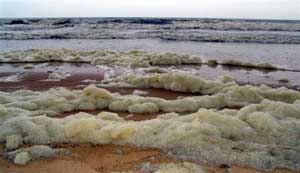 |
|
The bloom of Phaeocystis globosa, also known as filamentous algae, created foam along the coast of Binh Thuan in April 2005 – Photo: Binh Thuan Department of Science and Technology |
Dr. Nguyen Ngoc Lam, head of the Marine Phytoplankton Department at Nha Trang Oceanographic Institute (Vietnam Academy of Science and Technology), reported that at least 44 species of toxic microalgae have been identified in the waters of Khanh Hoa.
In other coastal regions across the country, scientists have discovered at least 70 species of algae capable of producing harmful toxins for humans. Meanwhile, research has documented that there are approximately 300 species of phytoplankton worldwide that can form blooms with densities reaching millions of cells per liter.
About one-quarter of the species that cause blooms have the potential to produce toxins. According to Dr. Lam, this poses a significant threat and can devastate both animal and plant ecosystems, as well as impact human health. Numerous scientific studies have recorded the accumulation of algal toxins in fish or shellfish.
The chemical structures of natural algal toxins vary greatly; however, they cannot be destroyed or reduced even when cooked at high temperatures. Notably, algal toxins do not affect the taste of food, making them harder for humans to detect.
Q.T.


















































